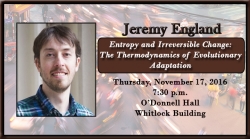Jeremy England
Jeremy England is Thomas D. and Virginia W. Cabot Career Development Assistant Professor at the Massachusetts Institute of Technology, having joined the MIT Physics Department in September 2011. Born in Boston, Jeremy grew up in a small college town near the New Hampshire seacoast. After earning a bachelor's degree in biochemistry from Harvard in 2003, he began his graduate studies at the University of Oxford, and subsequently completed his doctorate in physics at Stanford in 2009. Before coming to MIT, he spent two years as a lecturer and research fellow at Princeton University. Dr. England was a Rhodes Scholar and a Goldwater Scholar, and has received many other awards and recognitions for his work. His work on “dissipative adaptation” and the possibility of self-organizing life in the early universe has made waves in the fields of Biophysics and Cosmology, as well as being featured in more popular outlets including NPR, Nautilus, Quanta, Harper’s, and Forbes Magazine. The implications of Dr. England’s theory are so magnificent, that Pulitzer-Prize winning historian of science Edward J. Larson has said that if his ideas can be proven experimentally, “he could be the next Darwin.”
Professor England's research is directed towards understanding the patterns of organization in space and time that form the basis of life at the molecular level. Which arrangements of macromolecules in the cytosol are consistent with cell survival? How do a protein's form and function arise from its linear architecture? What are the physical conditions necessary for the emergence of self-replicating molecular forms capable of evolution? What these and other questions of interest all have in common is that they point to theoretical physics as a means to make better sense of fundamentally biological phenomena. The overall objective is to chart a course of inquiry that traces the boundary between inanimate and living matter.
As head of his own lab at MIT, Jeremy England coordinates the England research group, which aims to span the range from the basically theoretical to the medically practical: theoretical through the construction of analytical models and computer simulations from the concepts of statistical mechanics, and practical through the development of new computational tools for biologists, as well as through the establishment of close collaborations with experimenters in biomedical fields. For example, England has recently developed a new phenomenological theory of conformational fluctuations in polypeptide chains that successfully predicts the allosteric motions of many globular proteins (Structure, 2011). Future work will not only focus on elaborating this theory's basis in the statistical mechanics of polymers, but also on its use in identifying druggable allosteric sites on proteins, as well as on its application to the in vivo characterization of mutant proteins known to undergo the deleterious misfolding and aggregation events that underlie human neurodegenerative disease.
Sponsored by the College of Science, the Office of Graduate Education and Research, the Department of Biological Sciences, the Department of Physics & Astronomy, and the Honors Program
Sources:
http://web.mit.edu/physics/people/faculty/england_jeremy.html
http://nautil.us/issue/34/adaptation/how-do-you-say-life-in-physics
http://www.timesofisrael.com/meet-the-orthodox-jewish-physicist-rethinking-the-origins-of-life/
Published on November 17, 2016
